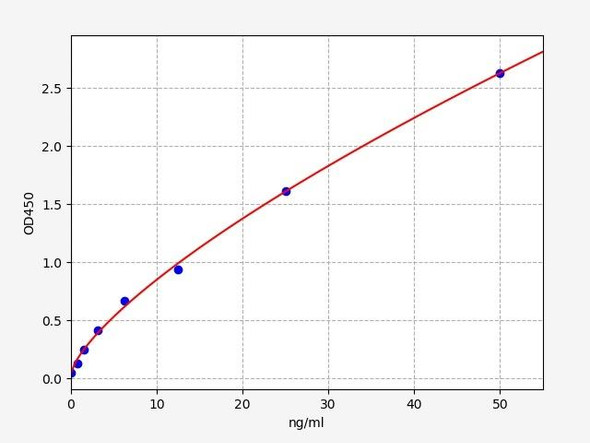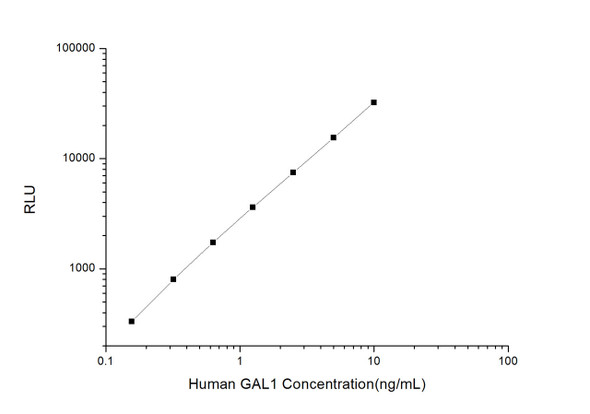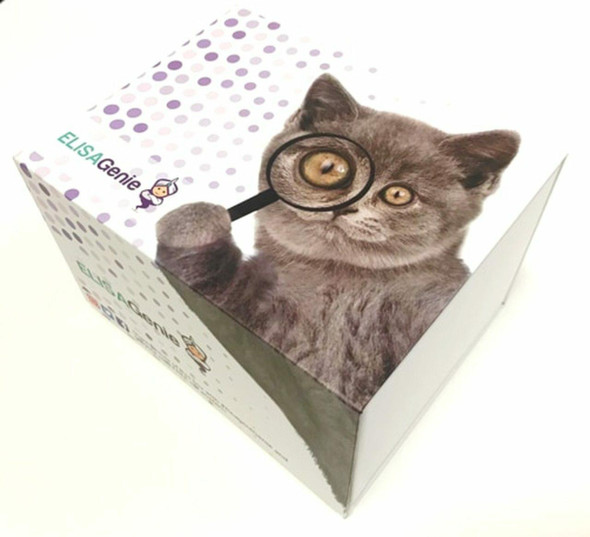Mouse Cell Death ELISA Kits
Mouse GAL1 (Galectin 1) CLIA Kit (MOES00274)
- SKU:
- MOES00274
- Product Type:
- ELISA Kit
- ELISA Type:
- CLIA Kit
- Size:
- 96 Assays
- Sensitivity:
- 0.09ng/mL
- Range:
- 0.16-10ng/mL
- ELISA Type:
- Sandwich
- Reactivity:
- Mouse
- Sample Type:
- Serum, plasma and other biological fluids
- Research Area:
- Cell Death
Description
| Assay type: | Sandwich |
| Format: | 96T |
| Assay time: | 4.5h |
| Reactivity: | Mouse |
| Detection method: | Chemiluminescence |
| Detection range: | 0.16-10 ng/mL |
| Sensitivity: | 0.09 ng/mL |
| Sample volume: | 100µL |
| Sample type: | Serum, plasma and other biological fluids |
| Repeatability: | CV < 15% |
| Specificity: | This kit recognizes Mouse GAL1 in samples. No significant cross-reactivity or interference between Mouse GAL1 and analogues was observed. |
This kit uses Sandwich-CLIA as the method. The micro CLIA plate provided in this kit has been pre-coated with an antibody specific to Mouse GAL1. Standards or samples are added to the appropriate micro CLIA plate wells and combined with the specific antibody. Then a biotinylated detection antibody specific for Mouse GAL1 and Avidin-Horseradish Peroxidase (HRP) conjugate are added to each micro plate well successively and incubated. Free components are washed away. The substrate solution is added to each well. Only those wells that contain Mouse GAL1, biotinylated detection antibody and Avidin-HRP conjugate will appear fluorescence. The Relative light unit (RLU) value is measured spectrophotometrically by the Chemiluminescence immunoassay analyzer. The RLU value is positively associated with the concentration of Mouse GAL1. The concentration of Mouse GAL1 in the samples can be calculated by comparing the RLU of the samples to the standard curve.
| UniProt Protein Function: | Galectin-1: May regulate apoptosis, cell proliferation and cell differentiation. Binds beta-galactoside and a wide array of complex carbohydrates. Inhibits CD45 protein phosphatase activity and therefore the dephosphorylation of Lyn kinase. Homodimer. Binds LGALS3BP. Interacts with CD2, CD3, CD4, CD7, CD43 and CD45. Interacts with laminin (via poly-N- acetyllactosamine). Expressed in placenta, maternal decidua and fetal membranes. Within placenta, expressed in trophoblasts, stromal cells, villous endothelium, syncytiotrophoblast apical membrane and villous stroma. Within fetal membranes, expressed in amnion, chorioamniotic mesenchyma and chorion. Expressed in cardiac, smooth, and skeletal muscle, neurons, thymus, kidney and hematopoietic cells. |
| UniProt Protein Details: | Protein type:Cell adhesion Cellular Component: extracellular matrix; proteinaceous extracellular matrix; extracellular space; cell surface; cytoplasm; extracellular region; intracellular; nucleus Molecular Function:signal transducer activity; protein binding; protein homodimerization activity; lactose binding; galactose binding; laminin binding; galactoside binding; carbohydrate binding; glycoprotein binding Biological Process: heterophilic cell adhesion; myoblast differentiation; positive regulation of I-kappaB kinase/NF-kappaB cascade; plasma cell differentiation; apoptosis; T cell costimulation; positive regulation of erythrocyte aggregation; signal transduction |
| UniProt Code: | P16045 |
| NCBI GenInfo Identifier: | 126172 |
| NCBI Gene ID: | 16852 |
| NCBI Accession: | P16045. 3 |
| UniProt Secondary Accession: | P16045,P05163, P11946, P17601, Q4FZH4, Q99M27, Q9D0X0 |
| UniProt Related Accession: | P16045 |
| Molecular Weight: | 14,866 Da |
| NCBI Full Name: | Galectin-1 |
| NCBI Synonym Full Names: | lectin, galactose binding, soluble 1 |
| NCBI Official Symbol: | Lgals1 |
| NCBI Official Synonym Symbols: | L14; Gal-1; Galbp; L-14. 5; Lect14; AA410090; galectin-1 |
| NCBI Protein Information: | galectin-1; galaptin; 14 kDa lectin; S-Lac lectin 1; lactose-binding lectin 1; beta-galactoside binding protein; lectin galactoside-binding soluble 1; beta-galactoside-binding lectin L-14-I |
| UniProt Protein Name: | Galectin-1 |
| UniProt Synonym Protein Names: | 14 kDa lectin; Beta-galactoside-binding lectin L-14-I; Galaptin; Lactose-binding lectin 1; Lectin galactoside-binding soluble 1; S-Lac lectin 1 |
| Protein Family: | Galectin |
| UniProt Gene Name: | Lgals1 |
| UniProt Entry Name: | LEG1_MOUSE |
As the RLU values of the standard curve may vary according to the conditions of the actual assay performance (e. g. operator, pipetting technique, washing technique or temperature effects), the operator should establish a standard curve for each test. Typical standard curve and data is provided below for reference only.
| Concentration (ng/mL) | RLU | Average | Corrected |
| 10 | 30843 34099 | 32471 | 32447 |
| 5 | 15353 15587 | 15470 | 15446 |
| 2.5 | 8171 6835 | 7503 | 7479 |
| 1.25 | 3492 3814 | 3653 | 3629 |
| 0.63 | 1815 1707 | 1761 | 1737 |
| 0.31 | 881 767 | 824 | 800 |
| 0.16 | 350 364 | 357 | 333 |
| 0 | 23 25 | 24 | -- |
Precision
Intra-assay Precision (Precision within an assay): 3 samples with low, mid range and high level Mouse GAL1 were tested 20 times on one plate, respectively.
Inter-assay Precision (Precision between assays): 3 samples with low, mid range and high level Mouse GAL1 were tested on 3 different plates, 20 replicates in each plate.
| Intra-assay Precision | Inter-assay Precision | |||||
| Sample | 1 | 2 | 3 | 1 | 2 | 3 |
| n | 20 | 20 | 20 | 20 | 20 | 20 |
| Mean (ng/mL) | 0.49 | 0.86 | 4.08 | 0.45 | 0.82 | 4.29 |
| Standard deviation | 0.05 | 0.10 | 0.26 | 0.05 | 0.08 | 0.35 |
| C V (%) | 10.20 | 11.63 | 6.37 | 11.11 | 9.76 | 8.16 |
Recovery
The recovery of Mouse GAL1 spiked at three different levels in samples throughout the range of the assay was evaluated in various matrices.
| Sample Type | Range (%) | Average Recovery (%) |
| Serum (n=5) | 92-107 | 98 |
| EDTA plasma (n=5) | 86-98 | 91 |
| Cell culture media (n=5) | 90-102 | 95 |
Linearity
Samples were spiked with high concentrations of Mouse GAL1 and diluted with Reference Standard & Sample Diluent to produce samples with values within the range of the assay.
| Serum (n=5) | EDTA plasma (n=5) | Cell culture media (n=5) | ||
| 1:2 | Range (%) | 89-101 | 86-100 | 101-116 |
| Average (%) | 94 | 91 | 108 | |
| 1:4 | Range (%) | 93-108 | 92-105 | 95-109 |
| Average (%) | 100 | 98 | 101 | |
| 1:8 | Range (%) | 104-117 | 88-103 | 87-98 |
| Average (%) | 110 | 94 | 93 | |
| 1:16 | Range (%) | 87-98 | 90-102 | 87-99 |
| Average (%) | 92 | 97 | 93 |
An unopened kit can be stored at 4°C for 1 month. If the kit is not used within 1 month, store the items separately according to the following conditions once the kit is received.
| Item | Specifications | Storage |
| Micro CLIA Plate(Dismountable) | 8 wells ×12 strips | -20°C, 6 months |
| Reference Standard | 2 vials | |
| Concentrated Biotinylated Detection Ab (100×) | 1 vial, 120 µL | |
| Concentrated HRP Conjugate (100×) | 1 vial, 120 µL | -20°C(shading light), 6 months |
| Reference Standard & Sample Diluent | 1 vial, 20 mL | 4°C, 6 months |
| Biotinylated Detection Ab Diluent | 1 vial, 14 mL | |
| HRP Conjugate Diluent | 1 vial, 14 mL | |
| Concentrated Wash Buffer (25×) | 1 vial, 30 mL | |
| Substrate Reagent A | 1 vial, 5 mL | 4°C (shading light) |
| Substrate Reagent B | 1 vial, 5 mL | 4°C (shading light) |
| Plate Sealer | 5 pieces | |
| Product Description | 1 copy | |
| Certificate of Analysis | 1 copy |
- Set standard, test sample and control (zero) wells on the pre-coated plate and record theirpositions. It is recommended to measure each standard and sample in duplicate. Note: addall solutions to the bottom of the plate wells while avoiding contact with the well walls. Ensuresolutions do not foam when adding to the wells.
- Aliquot 100µl of standard solutions into the standard wells.
- Add 100µl of Sample / Standard dilution buffer into the control (zero) well.
- Add 100µl of properly diluted sample (serum, plasma, tissue homogenates and otherbiological fluids. ) into test sample wells.
- Cover the plate with the sealer provided in the kit and incubate for 90 min at 37°C.
- Aspirate the liquid from each well, do not wash. Immediately add 100µL of BiotinylatedDetection Ab working solution to each well. Cover the plate with a plate seal and gently mix. Incubate for 1 hour at 37°C.
- Aspirate or decant the solution from the plate and add 350µL of wash buffer to each welland incubate for 1-2 minutes at room temperature. Aspirate the solution from each well andclap the plate on absorbent filter paper to dry. Repeat this process 3 times. Note: a microplatewasher can be used in this step and other wash steps.
- Add 100µL of HRP Conjugate working solution to each well. Cover with a plate seal andincubate for 30 min at 37°C.
- Aspirate or decant the solution from each well. Repeat the wash process for five times asconducted in step 7.
- Add 100µL of Substrate mixture solution to each well. Cover with a new plate seal andincubate for no more than 5 min at 37°C. Protect the plate from light.
- Determine the RLU value of each well immediately.






